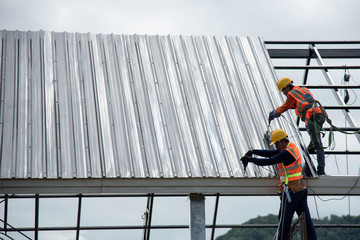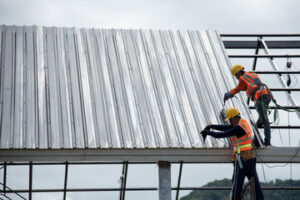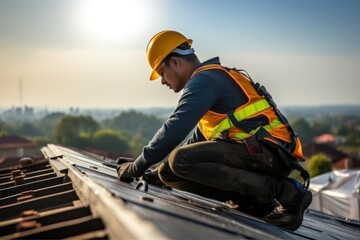When a roof is maintained correctly, it can help regulate indoor temperatures, reduce energy consumption, and keep a home dry. A well-maintained roof will also last longer and require fewer repairs than one neglected.

Most of the maintenance tasks that need to be done on a roof can be performed by the homeowner with a ladder and some tools, including visual inspections, gutter cleaning, and debris removal. Contact North Port FL Roofing for professional help.
Roof flashing is a metal or other material that seals joints and transitions on your roof, such as chimneys, vents and valleys. These areas tend to be leak-prone and can be a source of major damage if not properly maintained.
During a regular inspection, an expert will look for signs of deterioration on your roof flashing. This can include leaks in the roof, rust or cracking. This is one of the most important parts of a roofing maintenance plan and can help protect your investment in the property and avoid costly repairs later on.
The flashing around openings on the roof, such as chimneys, skylights and vents are also important to check. These are often sealed when the roof is installed but can become vulnerable over time. A professional will ensure that the seals are still intact and that no water is getting in through these areas.
Sloped roofs require regular inspections to check shingles, flashing and gutters for any signs of problems. These issues can often be resolved in the early stages, preventing a major repair bill. A professional will also take the opportunity to clear any debris that has accumulated on the roof and will clean the gutters to ensure that they are working well.
Many manufacturers offer warranty protection for roof products and these may require annual professional roof maintenance to be valid. Having your roof regularly inspected by an expert can prevent problems before they occur and can help you get the most out of your roofing system for years to come.
If you are looking for a roofing contractor to provide regular maintenance and repairs for your commercial or residential property, contact us today to request a quote. We have a team of experts that are highly experienced and trained in providing quality roof maintenance and repairs. We will assess your needs, inspect your roof and provide a written report outlining the recommended services to be performed. We will then schedule a convenient time for our crew to perform these maintenance and repair works. We will keep you updated throughout the process and once we have completed the work, our crew will notify you to arrange payment and pickup of any equipment.
Inspect the Attic
The attic is a critical component to the roof system, but is often neglected when performing roofing maintenance. A comprehensive attic inspection can identify insulation problems, ventilation concerns, moisture and mold growth, structural damages and pest infestations. Prioritizing attic inspections can help homeowners save money on energy bills, maintain a comfortable living environment, prolong the lifespan of their roof and home structure, and ensure the safety and comfort of their family.
During an attic inspection, a professional home inspector will evaluate the condition of the attic’s insulation and look for signs of water intrusion, such as stained or warped roof sheathing and framing. They will also check for vent pipes that protrude through the attic and any stains or drips on eave liners, as these are all potential signs of a leak. They will also look for ice dams in the winter, as these are typically caused by poor attic insulation and ventilation.
If a homeowner is comfortable with accessing their attic, they can perform an inspection themselves. However, it is important to wear proper personal protective equipment, including a hard hat and gloves, before entering the attic. A flashlight is also helpful, as attics are generally poorly lit. It is best to inspect the attic on a rainy day, as this will make it easier to spot signs of moisture penetration.
An attic inspection will also include a thorough assessment of the roof vents and skylights, as they are key to preventing unwanted moisture penetration. Depending on the type of roof, these vents may be neoprene pipe boots, ridge vents, or turbine vents. They should be properly installed and free from any obstructions, such as leaves, dust and debris. In addition, a home owner should check for rust on the vent pipes and scuttle holes, as these can cause serious damage to a roof if not addressed promptly.
Homeowners should also look for signs of pest infestation, such as droppings, rodent tracks and chewed insulation and wiring. These pests can create significant damage to a roof, as they are drawn to the warmth and moisture of attics. An annual attic inspection can help homeowners keep pests out, and prevent the need for expensive repairs or replacements.
Inspect the Gutters
Gutters play an important role in preserving the structural integrity of your home or commercial building and preventing serious water damage. They do this by efficiently diverting rainwater away from the foundation. However, gutter functionality can be impeded by debris accumulation, damage, and harsh weather conditions. This means that you need to inspect and maintain your gutters regularly to ensure that they function properly.
You need to clean your gutters at least twice a year and after major storms to make sure that they are not clogged. Clogged gutters can cause rain or melting snow to overflow and ruin your landscape or exterior siding. In addition, they can allow water to accumulate on the roof, which can lead to a variety of problems including wood rot, mold, and shingle damage. Additionally, if the water is not diverted away from the roof, it can cause leaks inside the house.
During your gutter inspection, look for any dents or holes. You should also look for downspouts that are detached from the gutters or not draining properly. If you notice any of these issues, contact a professional roofing contractor to have them repaired as soon as possible.
When examining your gutters, it is also important to look for any rust or paint peeling. This can indicate that the gutters are corroding. Additionally, you should check for signs of rotting or corrosion on the gutter hangers. These should be repaired as soon as possible to avoid any damage to your gutters and roof.
If you are uncomfortable climbing a ladder or getting on your roof, it is best to hire a roofing or gutter cleaning professional to do the inspection and cleanup for you. This can prevent any serious injuries or property damage caused by falling off the ladder or from being caught in between shingles.
By taking the time to perform routine maintenance on your roof, you can help to protect it from damage and extend its lifespan. This will save you money in the long run as well as prevent minor issues from escalating into significant problems. In addition, it will give you peace of mind knowing that your investment and your family’s safety are protected.
Trim Trees
Trees can damage a roof and the structure of a house if their limbs fall. This is a common problem during storms and high winds. Having trees properly trimmed by an arborist or tree experts can help prevent these issues. An arborist can inspect your home and the surrounding trees, and recommend any steps to support the health and future growth of the trees while prioritizing roof and building safety.
A tree that is growing too close to the house can also impact the gutter system. This is because the branches can clog the gutters and cause water to back up into the house or the downspouts. This can lead to a number of problems, such as roof rot and mold growth. Having the branches of the trees trimmed can reduce the risk of this occurring and keep the gutters clear.
The regular trimming of the trees can also promote the health and beauty of the trees. It is recommended that you have all tree limbs trimmed that overhang your house. This will reduce the risk of limbs falling during storms and other adverse weather conditions. It will also prevent the limbs from touching or abrading the shingles, which can cause them to break and damage the roof.
Another benefit of this maintenance is to prevent the buildup of debris, such as twigs and leaves, around the eaves of your house. This debris can also clog the gutters, causing water to flow back up into the house during storms. By removing these branches, you can improve the efficiency of your gutters and eliminate the need to clean them regularly.
In addition, trimming the trees can also prevent damage to sidewalks, driveways, and the foundations of buildings from their roots. It can also ensure that utility lines are not in contact with any branches that could potentially cause damage during a power outage. Finally, regular pruning can help maintain the shape of the tree and promote airflow throughout the crown. This can reduce the risk of insect infestation and disease, while also increasing the overall health and growth of the tree.







